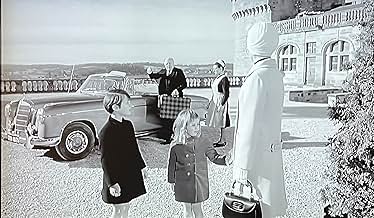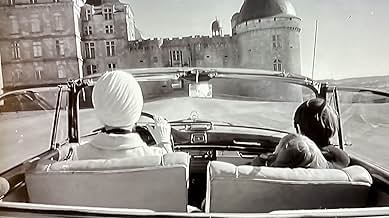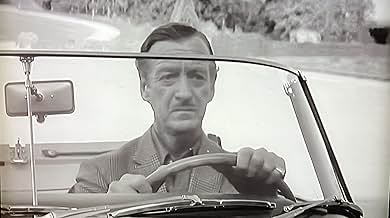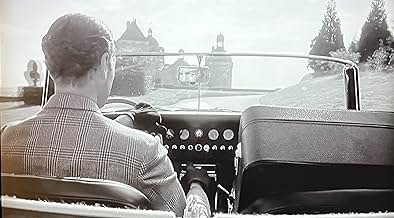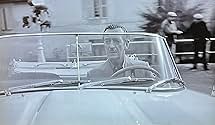CALIFICACIÓN DE IMDb
6.1/10
3.5 k
TU CALIFICACIÓN
Los trabajadores de un viñedo francés son parte de un antiguo culto pagano que requiere el sacrificio de la vida del marqués para salvar la cosecha en año de sequía.Los trabajadores de un viñedo francés son parte de un antiguo culto pagano que requiere el sacrificio de la vida del marqués para salvar la cosecha en año de sequía.Los trabajadores de un viñedo francés son parte de un antiguo culto pagano que requiere el sacrificio de la vida del marqués para salvar la cosecha en año de sequía.
- Dirección
- Guionistas
- Elenco
Chris Adcock
- Villager
- (sin créditos)
Hyma Beckley
- Villager
- (sin créditos)
Olwen Brookes
- Party Guest
- (sin créditos)
Opiniones destacadas
Historically speaking this film serves as an invaluable precursor to Anthony Shaffer's ingenious THE WICKER MAN, starring Edward Woodward and Christopher Lee. Taken on its own, however, EYE OF THE DEVIL is an effective but wildly uneven film.
The story deals with a wealthy French nobleman (David Niven) who is called back to his ancestral castle when the crops fail. Due to his erratic behavior regarding this summons, wife Deborah Kerr becomes increasingly worried about Niven's safety. Against his orders, Kerr takes her children to his ancestral castle, where she witnesses many strange and eerie religious rites. The question then becomes, will Kerr be able to rescue Niven from a ritual sacrifice, and -- indeed -- does he wish to be saved?
Owing to its erratic production history, it's not surprising that EYE OF THE DEVIL is a bit rough around the edges. The story is obtuse, and the characters under-developed, but director J. Lee Thompson employs an intriguingly arty approach that keeps one alert throughout. Thompson makes excellent use of Ernest Haller's mobil camerawork, most notably in a memorable race-against-the-clock climax. Additionally, the score is excellent, and the cast is well above average for this sort of thing. In the lead roles, Kerr and Niven are effective and restrained, but it is the supporting cast that really impresses: Donald Pleasence, his head shave completely bald, as a sinsiter cleric; David Hemmings as a seemingly evil youth; and especially Sharon Tate as Hemmings' enchantingly sensual/wicked sister.
In the end, EYE OF THE DEVIL cannot be considered a great film. It is, however, an above average diabolical thriller, and as such can be recommended to horror fans. My rating: *** out of ****
The story deals with a wealthy French nobleman (David Niven) who is called back to his ancestral castle when the crops fail. Due to his erratic behavior regarding this summons, wife Deborah Kerr becomes increasingly worried about Niven's safety. Against his orders, Kerr takes her children to his ancestral castle, where she witnesses many strange and eerie religious rites. The question then becomes, will Kerr be able to rescue Niven from a ritual sacrifice, and -- indeed -- does he wish to be saved?
Owing to its erratic production history, it's not surprising that EYE OF THE DEVIL is a bit rough around the edges. The story is obtuse, and the characters under-developed, but director J. Lee Thompson employs an intriguingly arty approach that keeps one alert throughout. Thompson makes excellent use of Ernest Haller's mobil camerawork, most notably in a memorable race-against-the-clock climax. Additionally, the score is excellent, and the cast is well above average for this sort of thing. In the lead roles, Kerr and Niven are effective and restrained, but it is the supporting cast that really impresses: Donald Pleasence, his head shave completely bald, as a sinsiter cleric; David Hemmings as a seemingly evil youth; and especially Sharon Tate as Hemmings' enchantingly sensual/wicked sister.
In the end, EYE OF THE DEVIL cannot be considered a great film. It is, however, an above average diabolical thriller, and as such can be recommended to horror fans. My rating: *** out of ****
Curiously solid, little occult psychological thriller that's sinisterly gloomy and consists of a banged-up ensemble cast featuring names like David Niven, Deborah Kerr, Donald Pleasance, David Hemming and Sharon Tate. A wealthy French nobleman returns back to his home town, along with his wife and children to help out with the town's failing vineyard. When there he tries to keep it secret from his wife, but she soon discovers the family tradition of Pagan sacrifice . The professionally classy performances are fitting, especially the support roles with Hemming and Tate really embellishing a creepy presence. Same for a cold-glazed Pleasance. Director J. Lee Thompson's atmospheric touch shows in many frames of this crisp b/w presentation, from the spooky castle, to the watching townsfolk and a disorientating chase scene through the castles nearby forest. It's attractively photographed, where Thompson also goes about providing some frenetic camera angles to lay out the anxiety of the circumstances. Despite some short-lived pockets, tension seems to be replaced by glum atmospherics in what feels like a slow-burn mood piece with a stringently compounded script breathing plenty of mystery and intrigue from that dark secret formula. Some things are not entirely explained, but it gives in to a devilish ending, but it's a very long build up to its foreseeable payoff. Some motions and actions of Kerr's concerned, but caring mother figure were somewhat an irritation. Niven is fine as the man tormented by his ancestral responsibilities, but it doesn't ask too much from him. While Kerr was the opposite with her emotive turn. The music score is melodically haunting in its angelic cues. A wickedly sleepy black mass thriller.
"Drive out of this valley. Never come back.".
"Drive out of this valley. Never come back.".
Eye of the Devil doesn't exactly have a good reputation, but much of the criticism aimed at it is rather unfair in my opinion; as while the film certainly could have been a lot better considering the plot and the cast; this British chiller isn't bad at all, and certainly provided this viewer with enough chills and suspense. Based on a novel by Philip Loraine, Eye of the Devil could be called a predecessor to the great British occult classic 'The Wicker Man' as it features similar themes of devil worship and witchcraft. Although not as good as the later film, J. Lee Thompson's effort is still a more than interesting film that just about works in spite of the overly complicated and often confusing mess of a plot. The film follows vineyard owner marquis Philippe de Montfaucon, who is called back to his castle after a dry season. His wife and children follow him, despite his request for them to remain in London; and it's not long before the wife is on his case after she discovers him acting strangely. Things take a turn for the more sinister when the strange vineyard employees begin following ancient Pagan rituals...
The central locations; that being the castle and surrounding vineyard, are very well used, and benefit the film in that they lend it a thick, foreboding atmosphere. The plot revels in this atmosphere - and themes of witchcraft and devil worship are well used and at the forefront at all times. The film's biggest asset, however, is undoubtedly the cast list; and Eye of the Devil benefits from an array of present and future stars. Casino Royale stars David Niven and Deborah Kerr take the lead roles, and the pair are given excellent support by a young Donald Pleasance, as well as The Fearless Vampire Killers' Sharon Tate and a very eerie performance by Deep Red's David Hemmings. The only area that the film falls down on really is the writing; as it is often difficult to decipher exactly what is going on, and there is, perhaps, a little too much plot for a film of this nature. The story does allow for a number of standout moments, however; and scenes such as the one that Sharon Tate and Deborah Kerr share at the top of castle will stay in my memory for some time. Overall, this isn't a must see or classic film; but it's a decent horror effort and should appeal to horror fanatics.
The central locations; that being the castle and surrounding vineyard, are very well used, and benefit the film in that they lend it a thick, foreboding atmosphere. The plot revels in this atmosphere - and themes of witchcraft and devil worship are well used and at the forefront at all times. The film's biggest asset, however, is undoubtedly the cast list; and Eye of the Devil benefits from an array of present and future stars. Casino Royale stars David Niven and Deborah Kerr take the lead roles, and the pair are given excellent support by a young Donald Pleasance, as well as The Fearless Vampire Killers' Sharon Tate and a very eerie performance by Deep Red's David Hemmings. The only area that the film falls down on really is the writing; as it is often difficult to decipher exactly what is going on, and there is, perhaps, a little too much plot for a film of this nature. The story does allow for a number of standout moments, however; and scenes such as the one that Sharon Tate and Deborah Kerr share at the top of castle will stay in my memory for some time. Overall, this isn't a must see or classic film; but it's a decent horror effort and should appeal to horror fanatics.
This one gets a least a 7 just on the camera work: glorious black & white, lots of shadowy scenes shot in a creepy French castle. Add to the mix a gorgeous young Sharon Tate in her screen debut as a freekoid Pagan witchess and you have enough to hold my attention for 90 minutes! I thought it was great all the way around: story line, casting, sets, you name it. Lots to like: Pagan cults, weird ceremonies with dead doves, hooded figures dressed in black, a tomb in the woods, ritual sacrifice, and did I mention that the magnificent Sharon Tate is in this movie? David Niven is outstanding as the grim and proper heir to a cruel pagan tradition designed to save the failing vineyards of his fore fathers. Ignore the IMDb 5.5 average rating -- if you like 60's B&W British creepy chiller/thrillers, watch it!
It certainly has all the ingredients to make this a classic, but fails to make it through for me, despite the pretty impressive cast.
It does bring to mind the Deborah Kerr cult movie The Innocents, but doesn't quite get there. All the components are here, but I thought the lack of pacing of the film made this less effective entertainment.
It is interesting nonetheless if you can take the slower pace. The outside shots mostly take advantage of the set location in France in a castle or chateau, which adds to the atmosphere quite well. The film does have the feel though of being filmed the earlier 1960's, rather than in the second half, with the camera angles etc i.e. close up of the actor to the side of the shot with the action/plot developing in the distance. It's shot in black and white which works very well, just at this time in cinema, there was the colour explosion going on.
The two "youngsters" here, David Hemmings (died blond hair) and Sharon Tate certainly look good, which is handy, as they do not appear to have many lines. They mostly go for the quiet manacing look school of acting here.
For those who like a bit of S&M, Sharon Tate gets a whipping and seems to like it, but don't expect too much, and that includes any erotic scenes or nudity. Just as well, as they are not needed, although it may have made the film slightly more interesting if tastefully done.
Sharon goes through the film looking like a model here in nearly all of her screen time. Donald Pleasance is Donald Pleasance who gives most of his best acting with his eyes, and does not have the lines or role to make his performance more memorable, which is a shame. As to David Niven's performance, it was good enough, but no particular plaudits from me (or criticism). Deborah Kerr is quite good, and is trying reasonably hard I thought, as did Flora Robson.
It's a 60's, B/W film, driven by a pagan plot with the usual accoutrement's (monks in hoods etc), and if that is your thing then give it a go. Not an out and out classic, but is worthy of being mentioned with the best of this genre, and more as an interesting flawed cult movie for horror fans.
It does bring to mind the Deborah Kerr cult movie The Innocents, but doesn't quite get there. All the components are here, but I thought the lack of pacing of the film made this less effective entertainment.
It is interesting nonetheless if you can take the slower pace. The outside shots mostly take advantage of the set location in France in a castle or chateau, which adds to the atmosphere quite well. The film does have the feel though of being filmed the earlier 1960's, rather than in the second half, with the camera angles etc i.e. close up of the actor to the side of the shot with the action/plot developing in the distance. It's shot in black and white which works very well, just at this time in cinema, there was the colour explosion going on.
The two "youngsters" here, David Hemmings (died blond hair) and Sharon Tate certainly look good, which is handy, as they do not appear to have many lines. They mostly go for the quiet manacing look school of acting here.
For those who like a bit of S&M, Sharon Tate gets a whipping and seems to like it, but don't expect too much, and that includes any erotic scenes or nudity. Just as well, as they are not needed, although it may have made the film slightly more interesting if tastefully done.
Sharon goes through the film looking like a model here in nearly all of her screen time. Donald Pleasance is Donald Pleasance who gives most of his best acting with his eyes, and does not have the lines or role to make his performance more memorable, which is a shame. As to David Niven's performance, it was good enough, but no particular plaudits from me (or criticism). Deborah Kerr is quite good, and is trying reasonably hard I thought, as did Flora Robson.
It's a 60's, B/W film, driven by a pagan plot with the usual accoutrement's (monks in hoods etc), and if that is your thing then give it a go. Not an out and out classic, but is worthy of being mentioned with the best of this genre, and more as an interesting flawed cult movie for horror fans.
¿Sabías que…?
- TriviaThis movie spent a long time on the shelf. Filming was completed in the early part of 1966, but its American release was not until late 1967, and its British one not until the spring of 1968. David Hemmings made this movie before his breakthrough role in Blow-Up. Deseo de una mañana de verano (1966), and it is quite possible that the great (and unexpected) popularity of that movie was what finally pushed MGM into releasing this one. Many commented with surprise on the smallness of Hemmings' role - it is likely that his special billing, along with that of Sharon Tate, was an afterthought to disguise the fact that they had supporting parts. Although this movie was supposed to launch Tate, she had, because of its protracted shelf-life, already been seen in No hagan olas (1967), which she had made subsequently. That movie has a special "introducing" credit for her as a result.
- ErroresDavid Niven's character, Philippe, goes to a vineyard to inspect grapes, wearing a blazer with a button-down oxford underneath. After a cutaway scene to a different character, the view returns to Philippe in the vineyard. He is still wearing the same oxford but now he has a covering sweater-vest on instead of the blazer.
- Citas
Philippe de Montfaucon: Believe it, Catherine.
Catherine de Montfaucon: I just told you, I don't!
Philippe de Montfaucon: Believe it. Believe it. Believe it. Or leave here.
- Créditos curiososThe Turner print has the main title as "Eye of the Devil" but the ending credit lists the title as "13".
- Versiones alternativasThe "Turner" print uses "Eye of the Devil" as the main title; but, the end credit lists the title as "13". This print has a running time of 95 minutes.
- ConexionesEdited into Inside the Manson Gang (2007)
Selecciones populares
Inicia sesión para calificar y agrega a la lista de videos para obtener recomendaciones personalizadas
- How long is Eye of the Devil?Con tecnología de Alexa
- Is Philippe de Montfaucon and his family supposed to be French?
Detalles
Taquilla
- Presupuesto
- USD 3,000,000 (estimado)
- Total a nivel mundial
- USD 4,966
- Tiempo de ejecución1 hora 36 minutos
- Color
- Relación de aspecto
- 1.66 : 1
Contribuir a esta página
Sugiere una edición o agrega el contenido que falta

Principales brechas de datos
What is the Brazilian Portuguese language plot outline for El signo del diablo (1966)?
Responda

